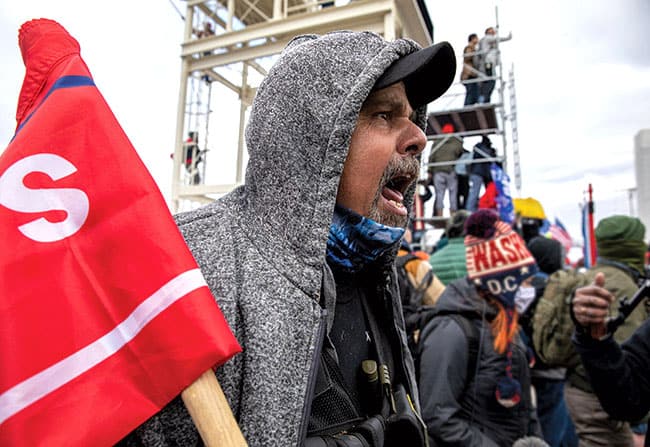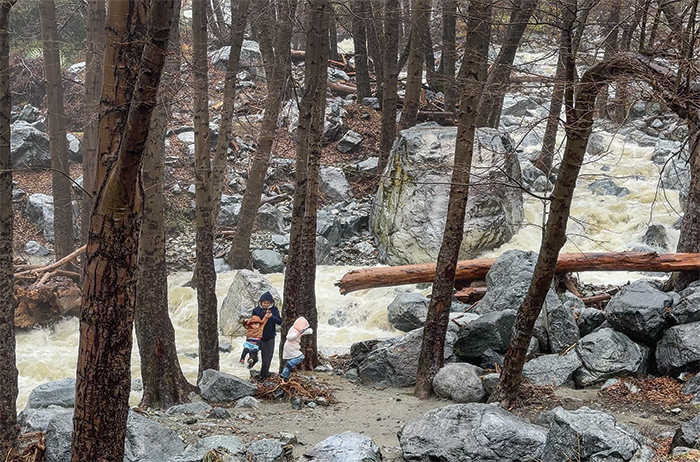A witness to American history – with podcast

by Andrew Alonzo | aalonzo@claremont-courier.com
Photos by Amanda Andrade-Rhoades/For The Washington Post
It seems like Claremont native Amanda Andrade-Rhoades was always destined to be a reporter. And after years of perseverance in the field, the 28-year-old freelance photojournalist recently became a Pulitzer Prize winner thanks to her contribution in the Washington Post’s coverage of the January 2021 insurrection.
Growing up, Andrade-Rhoades was a big news consumer, mostly because her father always had cable news on. Although she said television news was never her “thing,” she admits to dressing up as a newscaster for Halloween in 2002 during fourth grade at Condit Elementary School.
In 2010, Andrade-Rhoades received her first digital camera from her parents, a Canon Rebel XS, which she still has. Although she was never a part of the Wolfpacket, and instead part of the speech and debate team at Claremont High, the teenager taught herself the basics of photography.

Amanda Andrade-Rhoades
She took her Canon everywhere and recalled going through a few International Baccalaureate classes with the camera occupying her attention, but Amanda barely did enough to get by.
“I was, uhm … not a great student,” Andrade-Rhoades confessed. “There is no universe where I would have been voted most likely to succeed … I definitely got on the report card that I’m ‘a pleasure to have in class.’”
After graduating from CHS, Andrade-Rhoades attended the University of San Francisco, where she planned on majoring in psychology to become a therapist. However, life is life, and things didn’t go as planned.
During her freshman year, her love for photography, and need for friends, led to her joining the school newspaper, the San Francisco Foghorn. Her first assignment was covering a protest, where she remembers almost being arrested.
“That’s when I was like, this is what I want to do with the rest of my life,” she said. The next time she was on campus, she changed her major to media studies with an emphasis in journalism.
In the summer of 2012, she came down for an internship opportunity at her hometown paper, the Claremont COURIER. Under the guidance of Steven Felschundneff, the aspiring photographer honed her photographic eye.
A lot has happened for Andrade-Rhoades in the decade following that internship. She graduated from college in 2014, and two years later, switched coasts, moving into a Washington D.C. apartment she rented on Craigslist.
She took her first job on the east coast with D.C. Refine, and worked there for three years until the magazine folded in 2019. After months without work and losing out on other opportunities, Andrade-Rhoades turned to freelancing after networking with editors.
“It was around the time … let’s say near Trump’s first impeachment,” she recalled. “And really, I just hit the ground running.”
Since late 2019, she has become a frequent hire for the Washington Post, regularly contributing to the publication’s Metro section. Due to her proximity to the Capitol, Andrade-Rhoades also covers occasional political issues and protests. She has credits with the Associated Press and Wall Street Journal.
One of her biggest achievements in her post-COURIER career has been winning a Pulitzer for her work on the Post’s comprehensive coverage of the January 6, 2021 insurrection, “The Attack,” which won the Pulitzer for public service reporting on May 9, 2022.
She was on the ground capturing scenes from 11 a.m. to 6 p.m. Some of the images she took included insurrectionists occupying the Capitol steps and members of the crowd screaming their visible outrage at police officers.
“People were there to do violence, and harm people,” she said. “The insurrectionists were pulling the barricades away from [police] to break them apart, and then started using them as weapons to beat the police.”
“I’ve had people come up to me who know me and know I’ve covered it ask me if it was really that bad,” she said. “And I’m always very quick to say, ‘yes it was.’”
She saw insurrectionists climb scaffolding on the east side of the building, which is used during presidential inaugurations. Once she started to hear glass shatter, she knew insurrectionists infiltrated the building.
While still outside, sh
e remembers hearing a woman calling for the death of the Capitol police officers as the crowd made their way through. She could also taste the pepper spray police and insurrectionists deployed on one another through her gas mask.
Amid the chaos, she captured a photo of a young woman weeping into the chest of her husband, who was wearing a bulletproof vest with a QAnon patch and a California state flag sewn on it. The woman, wearing a Disney-themed backpack and exclaiming that the insurrectionists were there to save Capitol police, got Andrade-Rhoades thinking about those who attended the insurrection.
“What gets me is that the people who were there, they are not backwater hicks. They are your neighbors,” she said. “I have also seen, frankly on some cars in the [Claremont] area like logos related to the far-right groups that were there.”
“I think it’s a big mistake for us to think our neighbors are incapable of being extremists and that they’re incapable of attempting to perform a coup at the U.S. Capitol,” she added. “It is entirely likely that people from this area were there and I think it’s a mistake to think otherwise.”
As Andrade-Rhoades was submitting her photos to her editor in the evening, it dawned on her what she just documented was an attempted coup. She added that she hopes it was the first and last insurrection she’s ever called to cover.
Since the turn of 2022, Andrade-Rhoades was confident her insurrection photos would be up for a Pulitzer; however, she did not know which category she’d take home.
When May rolled around, Andrade-Rhoades was crushed to learn another entry had taken the Pulitzer for breaking news.
Crying on her boyfriend’s couch, she remembers her sobs being interrupted as messages from other photographers who contributed to “The Attack” began reaching her. Each wanted to know if they were included as part of the “Washington Post staff” that was announced for public service reporting. But Andrade-Rhoades was in the dark.
Initially, she thought she would not be included among the members of the team because she was a freelancer. But when the Post’s Director of Photography MaryAnne Golon emailed Andrade-Rhoades and the other photographers to spell check their names, that’s when it hit her.
She also contacted her editor at the Post, Mark Miller, who forgot he booked Andrade-Rhoades for January 6, and assigned her to cover the Capitol last minute. He, too, confirmed the photojournalist was included in the staff that won the Pulitzer Prize.
All who contributed to “The Attack,” including field reporters, photographers and videographers were included in the award-winning Washington Post staff.
The news is still sinking in for Andrade-Rhoades, who shared she’s thankful for the award.
Although memories of her not being the best student at CHS resurfaced when asked what the award meant to her, she said the award is “a vindication that if you’re really persistent, things will pay off for you.”
The photojournalist flew back to D.C. last week, and returns to the field in the coming days as she’s been assigned to cover Roe v. Wade protests.
As for the future, Andrade-Rhoades plans to keep producing local journalism. But January 6 will be a day that will stay in her memory for the remainder of her life.
For those interested in Andrade-Rhoades’ work, view her online portfolio at amandarhoadesphotography.com.















0 Comments